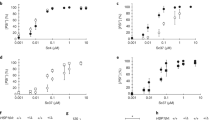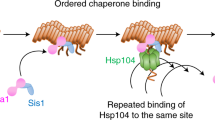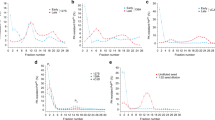Abstract
A principle that has emerged from studies of protein aggregation is that proteins typically can misfold into a range of different aggregated forms. Moreover, the phenotypic and pathological consequences of protein aggregation depend critically on the specific misfolded form1,2. A striking example of this is the prion strain phenomenon, in which prion particles composed of the same protein cause distinct heritable states3. Accumulating evidence from yeast prions such as [PSI+] and mammalian prions argues that differences in the prion conformation underlie prion strain variants3,4,5,6,7. Nonetheless, it remains poorly understood why changes in the conformation of misfolded proteins alter their physiological effects. Here we present and experimentally validate an analytical model describing how [PSI+] strain phenotypes arise from the dynamic interaction among the effects of prion dilution, competition for a limited pool of soluble protein, and conformation-dependent differences in prion growth and division rates. Analysis of three distinct prion conformations of yeast Sup35 (the [PSI+] protein determinant) and their in vivo phenotypes reveals that the Sup35 amyloid causing the strongest phenotype surprisingly shows the slowest growth. This slow growth, however, is more than compensated for by an increased brittleness that promotes prion division. The propensity of aggregates to undergo breakage, thereby generating new seeds, probably represents a key determinant of their physiological impact for both infectious (prion) and non-infectious amyloids.
This is a preview of subscription content, access via your institution
Access options
Subscribe to this journal
Receive 51 print issues and online access
$199.00 per year
only $3.90 per issue
Buy this article
- Purchase on Springer Link
- Instant access to full article PDF
Prices may be subject to local taxes which are calculated during checkout




Similar content being viewed by others
References
Caughey, B. & Lansbury, P. T. Protofibrils, pores, fibrils, and neurodegeneration: separating the responsible protein aggregates from the innocent bystanders. Annu. Rev. Neurosci. 26, 267–298 (2003)
Dobson, C. M. Protein folding and misfolding. Nature 426, 884–890 (2003)
Collinge, J. Prion diseases of humans and animals: their causes and molecular basis. Annu. Rev. Neurosci. 24, 519–550 (2001)
King, C. Y. & Diaz-Avalos, R. Protein-only transmission of three yeast prion strains. Nature 428, 319–323 (2004)
Tanaka, M., Chien, P., Naber, N., Cooke, R. & Weissman, J. S. Conformational variations in an infectious protein determine prion strain differences. Nature 428, 323–328 (2004)
Legname, G. et al. Synthetic mammalian prions. Science 305, 673–676 (2004)
Brachmann, A., Baxa, U. & Wickner, R. B. Prion generation in vitro: amyloid of Ure2p is infectious. EMBO J. 24, 3082–3092 (2005)
Wickner, R. B. [URE3] as an altered URE2 protein: evidence for a prion analog in Saccharomyces cerevisiae. Science 264, 566–569 (1994)
Tuite, M. F. & Koloteva-Levin, N. Propagating prions in fungi and mammals. Mol. Cell 14, 541–552 (2004)
Shorter, J. & Lindquist, S. Prions as adaptive conduits of memory and inheritance. Nature Rev. Genet. 6, 435–450 (2005)
Derkatch, I. L., Chernoff, Y. O., Kushnirov, V. V., Inge-Vechtomov, S. G. & Liebman, S. W. Genesis and variability of [PSI] prion factors in Saccharomyces cerevisiae. Genetics 144, 1375–1386 (1996)
Kochneva-Pervukhova, N. V. et al. [PSI+] prion generation in yeast: characterization of the ‘strain’ difference. Yeast 18, 489–497 (2001)
Kushnirov, V. V. & Ter-Avanesyan, M. D. Structure and replication of yeast prions. Cell 94, 13–16 (1998)
Bradley, M. E., Edskes, H. K., Hong, J. Y., Wickner, R. B. & Liebman, S. W. Interactions among prions and prion “strains” in yeast. Proc. Natl Acad. Sci. USA 99 (suppl. 4), 16392–16399 (2002)
Kryndushkin, D. S., Alexandrov, I. M., Ter-Avanesyan, M. D. & Kushnirov, V. V. Yeast [PSI+] prion aggregates are formed by small Sup35 polymers fragmented by Hsp104. J. Biol. Chem. 278, 49636–49643 (2003)
Castilla, J., Saa, P., Hetz, C. & Soto, C. In vitro generation of infectious scrapie prions. Cell 121, 195–206 (2005)
Krishnan, R. & Lindquist, S. L. Structural insights into a yeast prion illuminate nucleation and strain diversity. Nature 435, 765–772 (2005)
Cox, B., Ness, F. & Tuite, M. Analysis of the generation and segregation of propagons: entities that propagate the [PSI+] prion in yeast. Genetics 165, 23–33 (2003)
Collins, S. R., Douglass, A., Vale, R. D. & Weissman, J. S. Mechanism of prion propagation: amyloid growth occurs by monomer addition. PLoS Biol. 2, e321 (2004)
Satpute-Krishnan, P. & Serio, T. R. Prion protein remodelling confers an immediate phenotypic switch. Nature 437, 262–265 (2005)
DePace, A. H. & Weissman, J. S. Origins and kinetic consequences of diversity in Sup35 yeast prion fibers. Nature Struct. Biol. 9, 389–396 (2002)
Ness, F., Ferreira, P., Cox, B. S. & Tuite, M. F. Guanidine hydrochloride inhibits the generation of prion “seeds” but not prion protein aggregation in yeast. Mol. Cell. Biol. 22, 5593–5605 (2002)
Masel, J., Jansen, V. A. & Nowak, M. A. Quantifying the kinetic parameters of prion replication. Biophys. Chem. 77, 139–152 (1999)
Weissmann, C. The state of the prion. Nature Rev. Microbiol. 2, 861–871 (2004)
Hall, D. & Edskes, H. Silent prions lying in wait: a two-hit model of prion/amyloid formation and infection. J. Mol. Biol. 336, 775–786 (2004)
Tanaka, M., Chien, P., Yonekura, K. & Weissman, J. S. Mechanism of cross-species prion transmission: an infectious conformation compatible with two highly divergent yeast prion proteins. Cell 121, 49–62 (2005)
Ferreira, P. C., Ness, F., Edwards, S. R., Cox, B. S. & Tuite, M. F. The elimination of the yeast [PSI+] prion by guanidine hydrochloride is the result of Hsp104 inactivation. Mol. Microbiol. 40, 1357–1369 (2001)
Jung, G. & Masison, D. C. Guanidine hydrochloride inhibits Hsp104 activity in vivo: a possible explanation for its effect in curing yeast prions. Curr. Microbiol. 43, 7–10 (2001)
Silveira, J. R. et al. The most infectious prion protein particles. Nature 437, 257–261 (2005)
Santoso, A., Chien, P., Osherovich, L. Z. & Weissman, J. S. Molecular basis of a yeast prion species barrier. Cell 100, 277–288 (2000)
Acknowledgements
We thank G. Legname and S. Prusiner for communicating their results before publication, B. Cox and T. Serio for personal communication, and T. C. Keller III for providing us with chicken pectoralis extracts. We also thank C. Cunningham, J. Newman, L. Osherovich, M. Schuldiner, K. Tipton and members of the Weissman laboratory for helpful discussion and critical reading of the manuscript. M.T. was partly supported by JSPS and Uehara Memorial postdoctoral fellowships for research abroad. S.R.C. was supported by predoctoral fellowships from the Burroughs Wellcome Fund. Funding was also provided by the Howard Hughes Medical Institute, The David and Lucile Packard Foundation and the National Institutes of Health (J.S.W.). Author Contributions S.R.C. led the development of the analytical model. M.T. was responsible for the execution of the experiments, with the exception of the fibre growth studies, which were conducted by B.H.T. and M.T. M.T., S.R.C. and J.S.W. were primarily responsible for the design, interpretation and written description of the results.
Author information
Authors and Affiliations
Corresponding author
Ethics declarations
Competing interests
Reprints and permission information is available at npg.nature.com/reprintsandpermisions. The authors declare no competing financial interests.
Supplementary information
Supplementary Data
This file contains additional Methods, data and references. (DOC 295 kb)
Supplementary Figure 1
Supplementary Figure 1 nature04922-s2.pdf Introduction of a single prion fibre is sufficient to allow induction of a stable [PSI+] state. (PDF 47 kb)
Supplementary Figure 2
Ade1-14 read-through phenotype of typical [PSI+] strains produced by infection of [psi−] with in vitro produced Sc4, Sc37 and SCS Sup-NM amyloid fibres as well as a [psi−] control. (PDF 430 kb)
Supplementary Figure 3
Supplementary Figure 3 nature04922-s4.pdf Frequency of Sup-NM fibre length after physical shearing of fibres for 60 minutes. (PDF 32 kb)
Supplementary Figure 4
Effects of strains conformation on prion growth and division in vivo. (PDF 76 kb)
Supplementary Figure 5
Separation of in vivo prion particles of distinct strains by sucrose gradient. (PDF 111 kb)
Rights and permissions
About this article
Cite this article
Tanaka, M., Collins, S., Toyama, B. et al. The physical basis of how prion conformations determine strain phenotypes. Nature 442, 585–589 (2006). https://doi.org/10.1038/nature04922
Received:
Accepted:
Published:
Issue Date:
DOI: https://doi.org/10.1038/nature04922
This article is cited by
-
MIL-CELL: a tool for multi-scale simulation of yeast replication and prion transmission
European Biophysics Journal (2023)
-
Prion strains: shining new light on old concepts
Cell and Tissue Research (2023)
-
Amyloid conformation-dependent disaggregation in a reconstituted yeast prion system
Nature Chemical Biology (2022)
-
Innate immunity to prions: anti-prion systems turn a tsunami of prions into a slow drip
Current Genetics (2021)
-
Protein assembly systems in natural and synthetic biology
BMC Biology (2020)
Comments
By submitting a comment you agree to abide by our Terms and Community Guidelines. If you find something abusive or that does not comply with our terms or guidelines please flag it as inappropriate.



